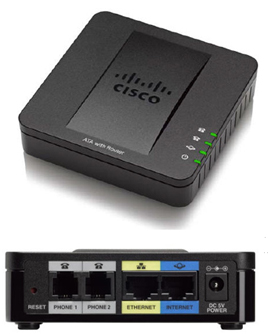VoIP Settings to Reduce Echo in your VoIP ATA.
 The
following settings can reduce echo in either Asterisk or an ATA
(Analog Telephone Adapter) device. These configurations can be
found in software
settings, if you can access the internal pages. Whether you are using a VoIP ATA or are using Asterisk
installed on a server, you
should be able to reduce voice echo by tweaking these configuration settings as
described. The following steps work
well, but are not a panacea to rid all instances of echo. When choosing a FXO or T1 card, obtain one with built-in echo cancellation
from the manufacturer, which incorporates noticeable elimination of echo.
The
following settings can reduce echo in either Asterisk or an ATA
(Analog Telephone Adapter) device. These configurations can be
found in software
settings, if you can access the internal pages. Whether you are using a VoIP ATA or are using Asterisk
installed on a server, you
should be able to reduce voice echo by tweaking these configuration settings as
described. The following steps work
well, but are not a panacea to rid all instances of echo. When choosing a FXO or T1 card, obtain one with built-in echo cancellation
from the manufacturer, which incorporates noticeable elimination of echo.
the following transmit and receive gain values Reduce Echo
- The transmit and receive gain settings in Asterisk (txgain and rxgain) can be set to negative values. These settings will act to reduce the sound volumes, but will also produce a more acceptable echo. Set txgain = –10 (or thereabouts) which should have a sufficient call volume with little perceived echo.
- For an Asterisk system, obtain cards, like T1 or FXO, with an echo cancellation chip built onto the card. Ultimately, the additional expense will be greatly appreciated by the better call quality.
- Make sure that no other device, including USB ports, are using the same IRQ as your gateway card. The installed card should be the only device that can use that particular IRQ.
- If the particular echo that you are experiencing is the type that results from leakage from the incoming voice to the outgoing voice, then some manufacturers of ATAs have TX and Rx Gain adjustments that can be set for the analog FXO port.
Lower transmit gain levels can help reduce VoIP echo in analog telephone adapters.
- Enter the edit page of the device. Locate the Tx Gain and Rx Gain settings. Start by lowering the values, then saving your changes. Test by making calls until the echo is moderated.
The default values set by the factory on some Cisco/Linksys ATAs can be too high.
The default settings for TX gain on the Cisco/Linksys PAP2T analog telephone adapter can come from the factory slightly high which can cause echo.
- Try adjusting the ATA's FXS Port Input Gain and FXS Port Output Gain, one setting at a time. Use increments of three to the approximate values of -1 and -11. Although these values vary dependent on network architecture and other hardware in use, you may find these values help eliminate echo and still produce an adequate volume.
- For Asterisk deployments, use zapata.conf files to adjust the rxgain and txgain.
Echo in VoIP, once a major problem, has mostly been eliminated through excellent use of echo cancellation hardware and appropriate software settings.
Checking Sangoma Cards for Echo Cancellation
To Verify that a Sangoma Card has hardware echo cancellation, type
the following in your Linux command line: wanrouter hwprobe
At
the end of the output, if you see either HWEC=0, which means No
Hardware Echo Canceller, or HWEC=anything, (but not 0), you have
Hardware Echo Cancellation.
Affordable telephony cards, FXS and FXO, from dependable sources:
Sangoma A20100DE 2 Port FXS
Analog Card w/Echo Cancellation (PCIe)
Sangoma A20300E 6 FXS analog card
- PCIe
FXO FXS Card with 2
FXO +2 FXS modules,Supports Issabel FreePBX Asterisknow Asterisk
Card PCI,for VoIP Telephone System SIP Phone Solution tdm400p